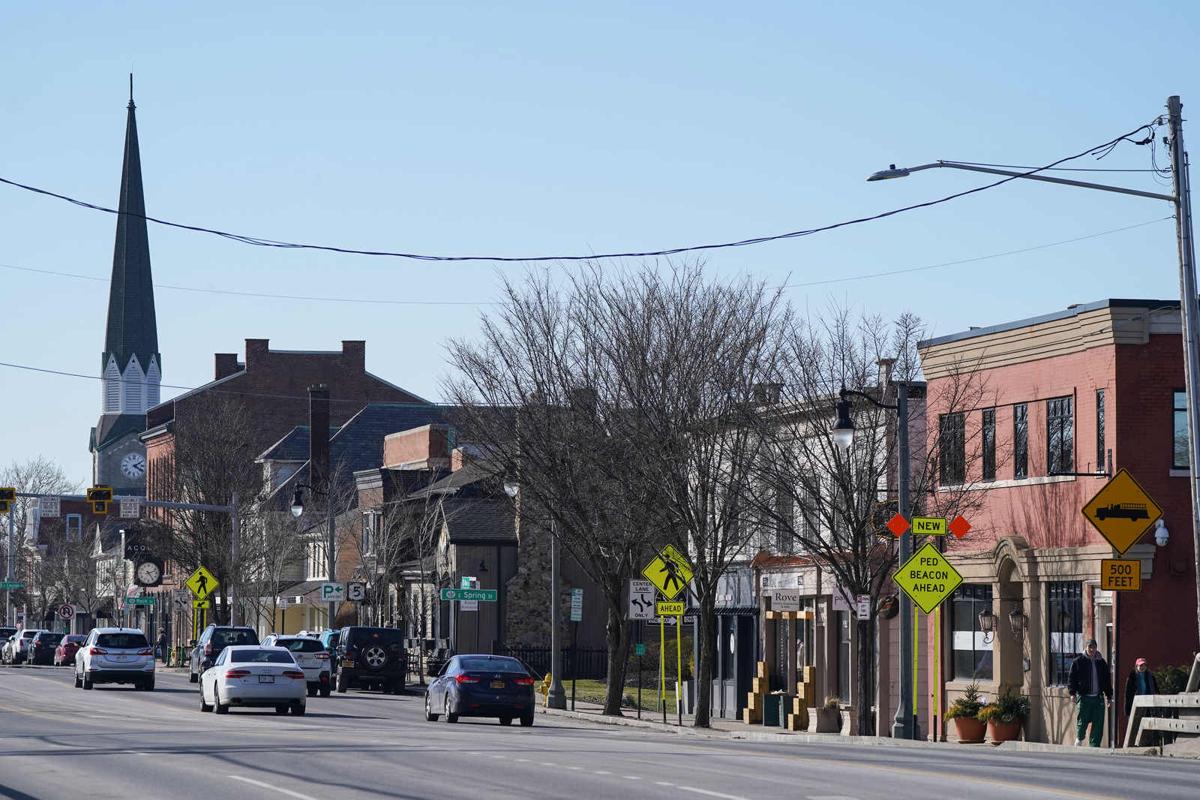
The sign greeting drivers on Main Street reads, “Welcome to the Historic Village of Williamsville / Founded 1800,” over an image of the Williamsville Water Mill.
It’s clear Williamsville embraces its history, even as decades of redevelopment and rising traffic have reshaped the Main Street corridor.
Nowhere is this more apparent than in the area around the mill, which sits near picturesque Glen Falls and was built by the village’s namesake more than 200 years ago.
Yet a proposal to set up a water mill historic district sparked pushback from some village residents and business owners.
The months-long debate, as is often the case in Williamsville, centered on the tension between encouraging investment in the village without sacrificing its historic identity.
The Village Board recently approved the inclusion of 13 commercial properties in the new district.
“This is a very important tool for our community to use to maintain the character of the village,” said Kate Waterman-Kulpa, an architect who chairs the village Historic Preservation Commission.
Critics say the creation of the district ignored property owners’ views and the decision on which properties to include seemed arbitrary.
“I felt that the criteria for such a designation was not being applied equally and not transparently enough,” said Dave Sherman, a longtime Amherst town historian and Amherst Bee editor who also served as Williamsville’s deputy mayor.
Waterman-Kulpa said officials for nearly two decades have studied whether to establish a village historic district, with the water mill as a focal point, so the idea is nothing new.
The first building at the water mill site, off Main Street along East Spring Street and Ellicott Creek, was constructed by Jonas Williams in 1811.
By 2005, the village government stepped in to rescue the mill from foreclosure and possible demolition.
The property now is owned by Howard and Tara Cadmus, owners of Sweet Jenny’s, who sell ice cream, chocolates and comic books from the main building and have tenants in two other buildings.
The Cadmuses supported the proposal, introduced by Waterman-Kulpa at the Aug. 23 Historic Preservation Commission meeting, to set up a historic district in the mill area.
“Historic designation is designed to help protect the investments of owners and residents from poorly planned development that undermines property values. It provides incentive, or at least it did for me, knowing our significant investment is protected over time,” Tara Cadmus wrote later to the Village Board.
The district as proposed ran along and to the north of Main Street, from Rock Street east to the pedestrian entrance to Glen Park. The district, focusing on construction between 1811 and 1949, had 13 properties: one on Rock, five on East Spring and seven on Main.

Derek Gee/Buffalo News
The list included the Eagle House restaurant, Moor Pat tavern, Share Kitchen & Bar Room and the Center for Plastic Surgery. Waterman-Kulpa said 10 of the 13 meet the criteria for local landmark designation.
“There’s such a cluster of historic buildings in the area. It has the oldest commercial buildings in the village. It made great sense to start there,” she said.
At the well-attended hearing in September, nearly all of the 16 speakers argued against the creation of the district or questioned the process, according to meeting minutes.
Several noted many buildings within the proposed district had been modified since their initial construction.
“I do feel that it’s important, especially with this historic district, that you have some kind of consensus,” Ray Herman, a lawyer who spoke that evening, said last week. Herman’s great-grandfather served as Williamsville mayor and ran a barbershop out of 5590 Main, now Share, and an uncle had a veterinary practice in the Moor Pat building.
Others questioned the sense of urgency and implored commission members to get more feedback from property owners. This included Chad Schlee, an owner of 15 Rock St., home to the Vibe Salon that his wife, Kelly, runs.
“I don’t see how we can survive, running a small business, with all these changes that could take place,” Schlee said, according to the Amherst Bee, which covered the district debate extensively. “People talk about how hard it would be to just change the aesthetics of it.”
At the well-attended hearing in September, nearly all of the 16 speakers argued against the creation of the district or questioned the process, according to meeting minutes.
Several noted many buildings within the proposed district had been modified since their initial construction.
“I do feel that it’s important, especially with this historic district, that you have some kind of consensus,” Ray Herman, a lawyer who spoke that evening, said last week. Herman’s great-grandfather served as Williamsville mayor and ran a barbershop out of 5590 Main, now Share, and an uncle had a veterinary practice in the Moor Pat building.
Others questioned the sense of urgency and implored commission members to get more feedback from property owners. This included Chad Schlee, an owner of 15 Rock St., home to the Vibe Salon that his wife, Kelly, runs.
“I don’t see how we can survive, running a small business, with all these changes that could take place,” Schlee said, according to the Amherst Bee, which covered the district debate extensively. “People talk about how hard it would be to just change the aesthetics of it.”
The Historic Preservation Commission on Oct. 25 voted to recommend the Village Board approve the district. The vote was 5-1 with Herman, now a commission member, voting no.
At the Village Board public hearing, which started Dec. 12 and carried over to Jan. 9, some of the same critics, joined by others, blasted the proposed district as unneeded and burdensome.
The few supporters said it was important to preserve historic village buildings because a number were lost to the wrecking ball in decades past.
Village Board members voted 4-1 on Jan. 23 to approve the district, with Mayor Deb Rogers the only “no” vote.
Waterman-Kulpa said she’s not surprised the district generated controversy, contending some of it is politically motivated, and she emphasized she is one of seven commission members.
Historic Preservation Commission reviews of proposed business expansions or renovations also have proven contentious.
This was the case when Share owner Joel Schreck last year sought permission to enclose the outdoor tables along one side of the restaurant and set out new patio seating on the roof of this addition.
After months of wrangling, commission members eventually issued a certificate of appropriateness for the project. The back and forth left Schreck frustrated. Waterman-Kulpa, however, described it as a collaborative process.
Looking ahead, what does inclusion in the district mean for Share and the 12 other properties?
Officials said it gives the village, through the commission, more say over any exterior changes.
Waterman-Kulpa points to the parking lots along East Spring Street and said the district designation also offers protection from future, multistory construction blocking the view of mill.
“We want development but we want it done appropriately,” she said in an interview.
Herman said the preservation debate raised valid questions. Not every old building is truly historic, he said, and many historic buildings – like Share’s – already have been significantly altered.
“I am all for historic districts but, really, this is not Colonial Williamsburg. It’s not Charleston, South Carolina. Or Savannah, Georgia,” he said.
Source: The Buffalo News





